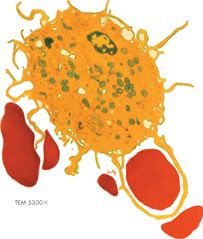Bulk Transport Larger molecules and even solid clumps of material can be transported by movements of the cell membrane known as bulk transport. Bulk transport can take several forms, depending on the size and shape of the material moved into or out of the cell.
▸ Endocytosis Endocytosis (en doh sy TOH sis) is the process of taking material into the cell by means of infoldings, or pockets, of the cell membrane. The pocket that results breaks loose from the outer portion of the cell membrane and forms a vesicle or vacuole within the cytoplasm. Large molecules, clumps of food, even whole cells can be taken up in this way.
Phagocytosis (fag oh sy TOH sis) is a type of endocytosis, in which extensions of cytoplasm surround a particle and package it within a food vacuole. The cell then engulfs it. Amoebas use this method for taking in food, and white blood cells use phagocytosis to “eat” damaged cells, as shown in Figure 7–20. Engulfing material in this way requires a considerable amount of energy and is considered a form of active transport.
In a process similar to phagocytosis, many cells take up liquid from the surrounding environment. Tiny pockets form along the cell membrane, fill with liquid, and pinch off to form vacuoles within the cell. This type of endocytosis is known as pinocytosis (py nuh sy TOH sis).
▸ Exocytosis Many cells also release large amounts of material, a process known as exocytosis (ek soh sy TOH sis). During exocytosis, the membrane of the vacuole surrounding the material fuses with the cell membrane, forcing the contents out of the cell. The removal of water by means of a contractile vacuole is one example of this kind of active transport.
BUILD Vocabulary
PREFIXES The prefix endo- in endocytosis comes from a Greek word meaning “inside” or “within.” The prefix exo- in exocytosis means “outside.”

FIGURE 7–20 Endocytosis The white blood cell seen here is engulfing a damaged red blood cell by phagocytosis—a form of endocytosis. Extensions, or “arms,” of the white blood cell's cell membrane have completely surrounded the red blood cell.
7.3 Assessment

-
Review What happens during diffusion?
Explain Describe the process of osmosis.
Compare and Contrast What is the difference between diffusion and facilitated diffusion?
-
Review How is active transport different from passive transport?
Explain Describe the two major types of active transport.
Compare and Contrast How is endocytosis different from exocytosis?
BUILD VOCABULARY
Based on the meanings of isotonic, hypertonic, and hypotonic, write definitions for the prefixes iso-, hyper-, and hypo-. Then come up with another set of words that uses these prefixes (the words do not need to have the same suffixes).
The prefix phago- means “to eat.” The prefix pino- means “to drink.” Look up the definition of -cytosis, and write definitions for phagocytosis and pinocytosis.

Table of Contents
- Formulas and Equations
- Applying Formulas and Equations
- Mean, Median, and Mode
- Estimation
- Using Measurements in Calculations
- Effects of Measurement Errors
- Accuracy
- Precision
- Comparing Accuracy and Precision
- Significant Figures
- Calculating With Significant Figures
- Scientific Notation
- Calculating With Scientific Notation
- Dimensional Analysis
- Applying Dimensional Analysis




